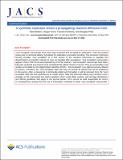Files in this item
A synthetic replicator drives a propagating reaction-diffusion front
Item metadata
| dc.contributor.author | Bottero, Ilaria | |
| dc.contributor.author | Huck, Juergen | |
| dc.contributor.author | Kosikova, Tamara | |
| dc.contributor.author | Philp, Douglas | |
| dc.date.accessioned | 2017-05-13T23:33:35Z | |
| dc.date.available | 2017-05-13T23:33:35Z | |
| dc.date.issued | 2016-06-01 | |
| dc.identifier | 242629789 | |
| dc.identifier | 24814e82-85d7-4f71-bddf-3b4a8e18a808 | |
| dc.identifier | 84973447832 | |
| dc.identifier | 000377151400008 | |
| dc.identifier.citation | Bottero , I , Huck , J , Kosikova , T & Philp , D 2016 , ' A synthetic replicator drives a propagating reaction-diffusion front ' , Journal of the American Chemical Society , vol. 138 , no. 21 , pp. 6723-6726 . https://doi.org/10.1021/jacs.6b03372 | en |
| dc.identifier.issn | 0002-7863 | |
| dc.identifier.other | ORCID: /0000-0002-9198-4302/work/56639223 | |
| dc.identifier.uri | https://hdl.handle.net/10023/10770 | |
| dc.description | The authors thank EPSRC for postgraduate studentship awards to JH (EP/ E017851/1) and TK (EP/K503162/1). | en |
| dc.description.abstract | A simple synthetic autocatalytic replicator is capable of establishing and driving the propagation of a reaction-diffusion front within a 50 µL syringe. This replicator templates its own synthesis through a 1,3-dipolar cycloaddition reaction between a nitrone component, equipped with a 9-ethynylanthracene optical tag, and a maleimide. Kinetic studies using NMR and UV-Vis spectroscopies confirm that the replicator forms ef-ficiently and with high diastereoselectivity and this rep-lication process brings about a dramatic change in opti-cal properties of the sample – a change in the color of the fluorescence in the sample from yellow to blue. The addition of a small amount of the pre-formed replicator at a specific location within a microsyringe, filled with the reaction building blocks, results in the initiation and propagation of a reaction-diffusion front. The realization of a replicator capable of initiating a reaction-diffusion front provides a platform for the examination of inter-connected replicating networks under non-equilibrium conditions involving diffusion processes. | |
| dc.format.extent | 4 | |
| dc.format.extent | 16015983 | |
| dc.language.iso | eng | |
| dc.relation.ispartof | Journal of the American Chemical Society | en |
| dc.subject | QD Chemistry | en |
| dc.subject | DAS | en |
| dc.subject | BDC | en |
| dc.subject.lcc | QD | en |
| dc.title | A synthetic replicator drives a propagating reaction-diffusion front | en |
| dc.type | Journal article | en |
| dc.contributor.sponsor | EPSRC | en |
| dc.contributor.institution | University of St Andrews. School of Chemistry | en |
| dc.contributor.institution | University of St Andrews. EaSTCHEM | en |
| dc.contributor.institution | University of St Andrews. Biomedical Sciences Research Complex | en |
| dc.identifier.doi | 10.1021/jacs.6b03372 | |
| dc.description.status | Peer reviewed | en |
| dc.date.embargoedUntil | 2017-05-13 | |
| dc.identifier.grantnumber | EP/E017851/1 | en |
This item appears in the following Collection(s)
Items in the St Andrews Research Repository are protected by copyright, with all rights reserved, unless otherwise indicated.

